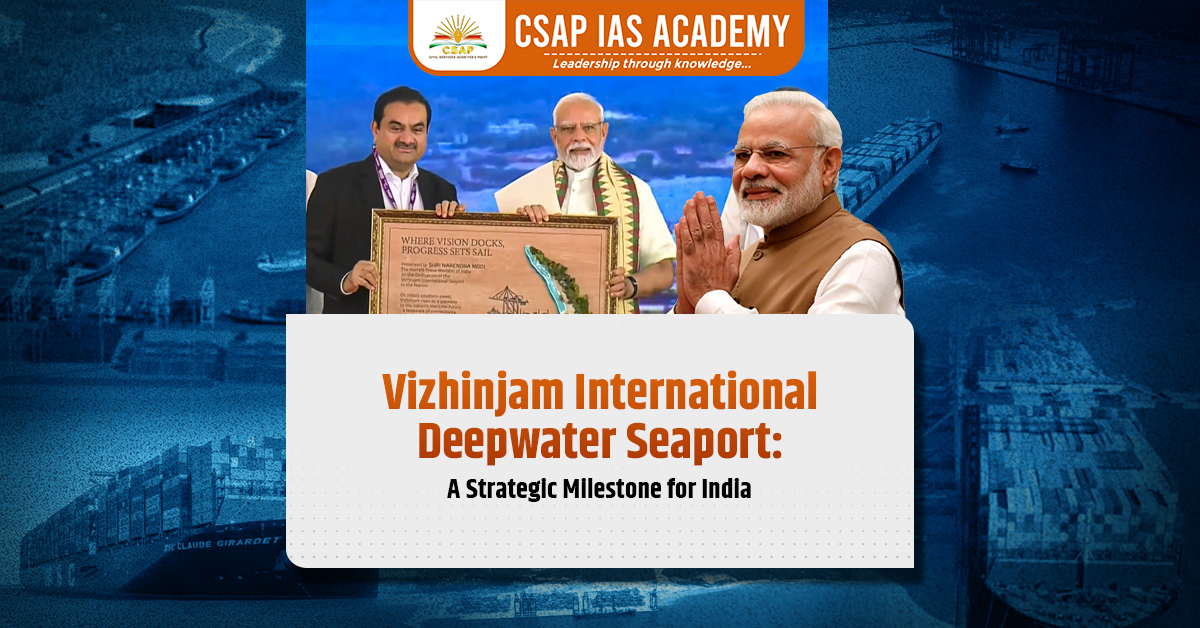The Vizhinjam Port, located near Thiruvananthapuram in Kerala, is India’s first deepwater transshipment port, commissioned by Prime Minister Narendra Modi in 2025. This port, a crucial development in India’s maritime infrastructure, is expected to significantly impact the nation’s shipping and economic landscape. The project, conceived in 1991, has overcome numerous challenges to become operational in 2025. It is built under a Public-Private Partnership (PPP) model, with an investment of ₹8,900 crore, a collaboration between the Kerala Government and the Adani Group.
What is a Transshipment Deepwater Seaport?
A transshipment deepwater seaport is a maritime facility that serves as a major hub for cargo transfer between large ocean-going vessels. These ports are located in areas with natural or engineered deepwater draft, enabling them to handle ultra-large container vessels (ULCVs) that carry over 18,000 TEUs (twenty-foot equivalent units).
Key Functions:
- Transshipment: Transfer of containers from one vessel to another for onward journey to final destination.
- Hub-and-Spoke Model: Acts as a central hub where mother ships offload containers which are then transported by feeder vessels to regional ports.
- Efficiency Enhancer: Helps optimize shipping routes, reduce costs, and minimize fuel usage.
Major Deepwater Transshipment Seaports Globally
| Port | Country |
| Singapore | Singapore |
| Shanghai | China |
| Shenzhen | China |
| Ningbo-Zhoushan | China |
| Busan | South Korea |
| Rotterdam | Netherlands |
| Antwerp | Belgium |
| Hamburg | Germany |
| Jebel Ali | United Arab Emirates |
| Los Angeles | United States |
| Long Beach | United States |
These ports handle significant portions of global containerized trade and serve as benchmarks in port management, infrastructure, and efficiency.
Key Features of Vizhinjam Port
Deepwater and Transshipment Capabilities
A deepwater port refers to a facility that can accommodate large cargo ships, particularly those carrying oil, gas, and bulk commodities. The Vizhinjam Port is designed to handle 18,000 TEU (Twenty-Foot Equivalent Unit) vessels. It will also function as a transshipment hub, where cargo is transferred between vessels in transit to their final destination. This feature will allow India to retain a larger portion of its cargo, which previously passed through foreign ports.
Strategic Location
Located just 11 nautical miles from major international shipping routes, Vizhinjam’s geographical positioning places it near a significant corridor where around 30% of global trade occurs. This strategic location makes it a natural choice for major global shipping lines, positioning India to become a more prominent player in the international shipping sector.
Capacity and Infrastructure
The first phase of the port has a handling capacity of 1 million TEUs, and this will increase to 3 million TEUs by 2028. The port’s breakwater measures 2,960 meters in length, providing shelter to the port and allowing safe operations. With a natural draft exceeding 18 meters, the port is capable of accommodating the largest container ships, which are vital for efficient global trade.
Technological Integration
The port will leverage advanced technologies such as AI-powered control rooms and a Vessel Traffic Management System (VTMS). These systems will ensure optimized traffic flow, improve operational efficiency, and enhance the monitoring of vessel movements.
Economic Impact
The Vizhinjam Port is expected to revolutionize India’s maritime trade by saving the country $220 million annually. Presently, around 75% of India’s transshipment cargo is handled by foreign ports such as Colombo in Sri Lanka, Singapore, and Jebel Ali in the UAE. This reliance results in higher costs and extended transit times, impacting Indian traders. By managing these operations domestically, the port will help India retain substantial revenue and reduce dependency on foreign ports.
Additionally, the port’s operation will enhance the resilience of India’s supply chains by insulating them from potential geopolitical disruptions. The new infrastructure will create a more stable and cost-effective environment for trade, benefiting industries that rely on timely and affordable shipping.
Financial and Developmental Aspects
The total investment in the port is ₹8,867 crore, with contributions from the Kerala Government (63%), Adani Group (28%), and a Central Government loan of ₹818 crore. The Adani Group has committed an additional ₹20,000 crore for further development, underscoring the importance of this project for the nation’s economic growth.
The project is being executed in four phases. While Phase I is operational, Phases II, III, and IV are expected to be completed by 2028. Upon completion, the port will significantly increase its capacity and become one of the largest transshipment hubs in South Asia.
Geopolitical and Strategic Significance
The port’s strategic importance extends beyond economics. As it lies near crucial shipping routes, it will contribute to the geopolitical stature of India. The port is not only expected to compete with other domestic ports like Cochin and Tuticorin but also with international giants such as Colombo and Salalah.
The project represents a significant step towards India’s maritime self-sufficiency, positioning Kerala as a prominent hub for international transshipment activities. The infrastructure at Vizhinjam will enhance India’s ability to control its maritime traffic, making the country a more competitive player in global trade.
Future Prospects and Conclusion
The Vizhinjam International Deepwater Seaport is expected to generate an annual economic advantage of ₹2,500 crore. With its sophisticated technology and strategic location, it is set to become one of the key pillars of India’s maritime infrastructure. The project’s successful completion will not only boost India’s trade but will also serve as a model for future investments in India’s shipping sector.
In conclusion, Vizhinjam Port is poised to be a game-changer in India’s shipping industry, offering significant economic, strategic, and geopolitical benefits. The project reflects the evolving vision of India’s infrastructure capabilities and its potential to become a global maritime hub.
Read: Pegasus Spyware Controversy









